by Jason Bodner
April 9, 2024
Noah’s Ark is a tale of one man’s family (and two of each species) surviving a mass cataclysm, a flood.
Interestingly, though, Noah’s family was not alone. A similar story of mass cataclysm (usually a flood, sometimes a fire), destroying the Earth appears in 70 different cultures around the world. They all share the theme of only a handful of humans surviving a terrible disaster. It’s a shared myth across continents.

Traditional wisdom has the cradle of civilization beginning in Samaria about 6,000 years ago. Prior to that, we were Neanderthals … or so the theory goes. But other theories have emerged in the last 30 years that suggest a lost civilization between the two. The prime proponent of this theory is Graham Hancock. For decades, many prominent archaeologists taunted him by saying: “Show me one shred of proof of evidence of a civilization prior to 6,000 years ago and we will reconsider your theories.’
His cause was lonely and unvindicated… until Gobekli Tepi was unearthed in modern Turkey. It is a megalithic site confirmed to be intentionally buried 12,800 years ago. And now, more evidence is popping up to support his claims. Rain erosion at the Sphinx suggests it was around a lot longer than the accepted 4,500 years ago. Water erosion evidence suggests it could have been staring down at us 11,000 years ago.

Do I have the answers? Sorry, I can offer no proof. I am no archaeologist, but I concede, as a scientist, that it is possible. The whole point of science is to keep proving prior science wrong until we arrive at what we believe to be truth. Still, any new truths are subject to scrutiny and further possibility of disproof.
You see, that’s the trouble with dogmas, any truth that we take as law. It is right until it is proven wrong. Consider how much we have learned about our planet and solar system in the last 100 years.
That’s sometimes how it must feel looking at the stock market through the lens of my unusual bank of data. Using my proprietary system to rank stocks and isolate unusual money flows makes perfect sense to me, but it can fly in the face of mainstream accepted “facts” about how stocks and markets ‘should’ work.
Several people reached out to me last week regarding the volatility and price action of the past few days. They were concerned and wondering what I thought about the news, which is rife with negativity. Middle East tensions continue to heat up. Oil surged. The fed language from Neel Kashkari splashed cold water on what seemed like a nice run for stocks. The media would have us believe that a crash is on its way.
Should we start building an Ark for our family (and pets, and maybe some trusted friends)?
From my perspective, the answer lies in whether there has been a shift in money flows. The answer, in short, is that there has NOT been such a shift. So, let’s check in on the facts, first in chart form.
The Big Money Index (BMI) continues to meander sideways after falling from overbought in December:
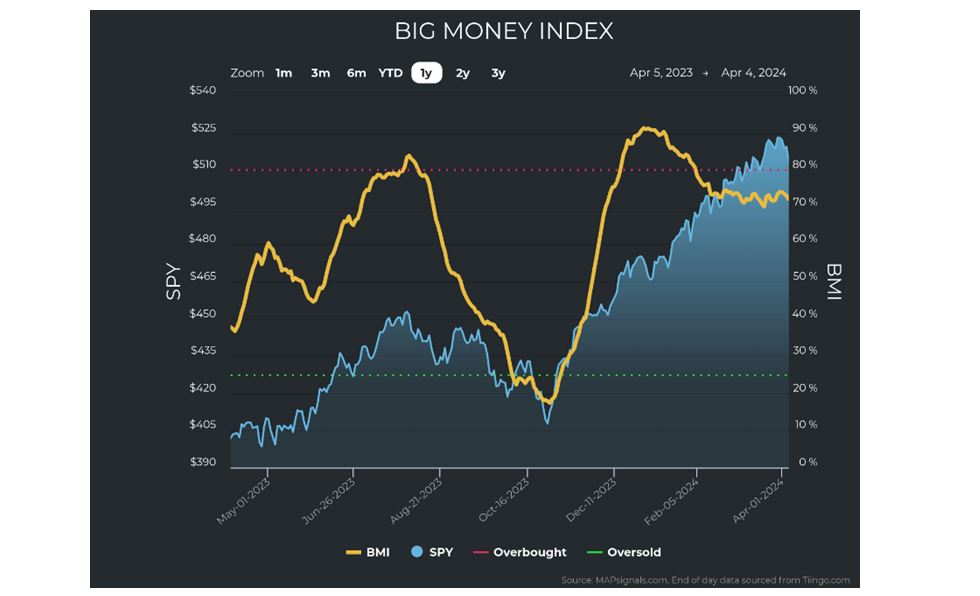
Graphs are for illustrative and discussion purposes only. Please read important disclosures at the end of this commentary.
Clearly the market has remained strong since falling from overbought. The latest dip, however, got some nerves rattled. To contextualize, let’s see if there was an uptick in unusual selling. In the charts below, we can see that the weather looks great in both stocks and ETFs: No big increase in unusually large selling:
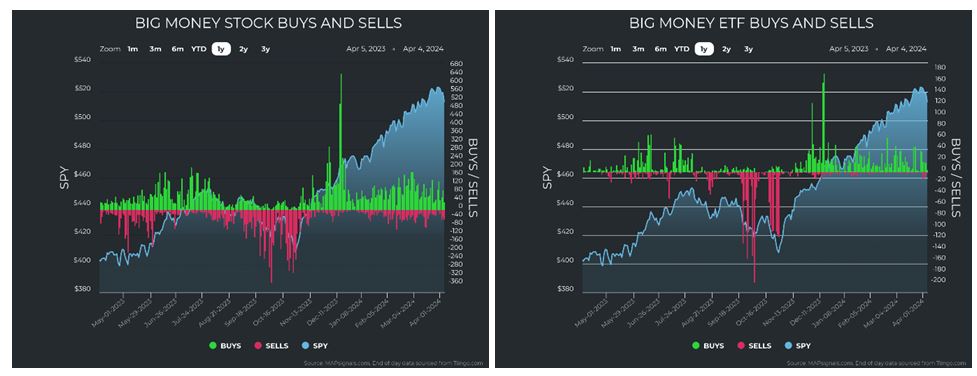
Graphs are for illustrative and discussion purposes only. Please read important disclosures at the end of this commentary.
One crucial aspect of creating an unusual sell signal in our data is that a security must breach an 11-week low, accompanied by abnormal volume and volatility. There’s nothing to speak of in that regard. Even when we look at market cap, we see nothing to be concerned about, as buying outnumbers selling:
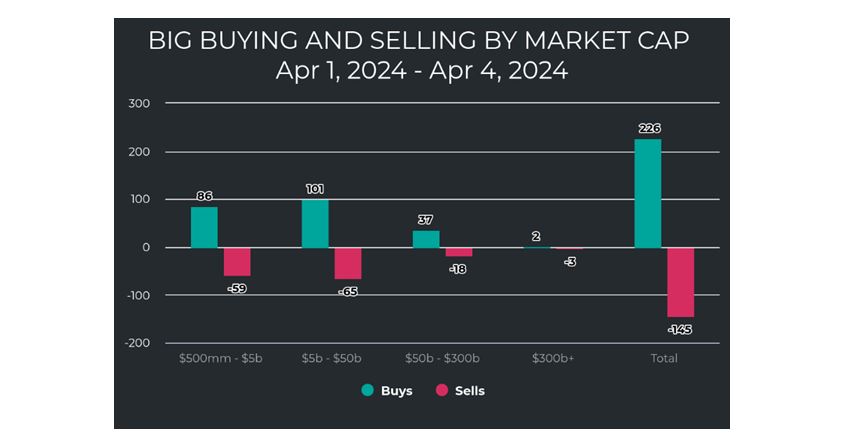
Graphs are for illustrative and discussion purposes only. Please read important disclosures at the end of this commentary.
The next place to monitor is the sector action. First, we look into the ranking of sectors:
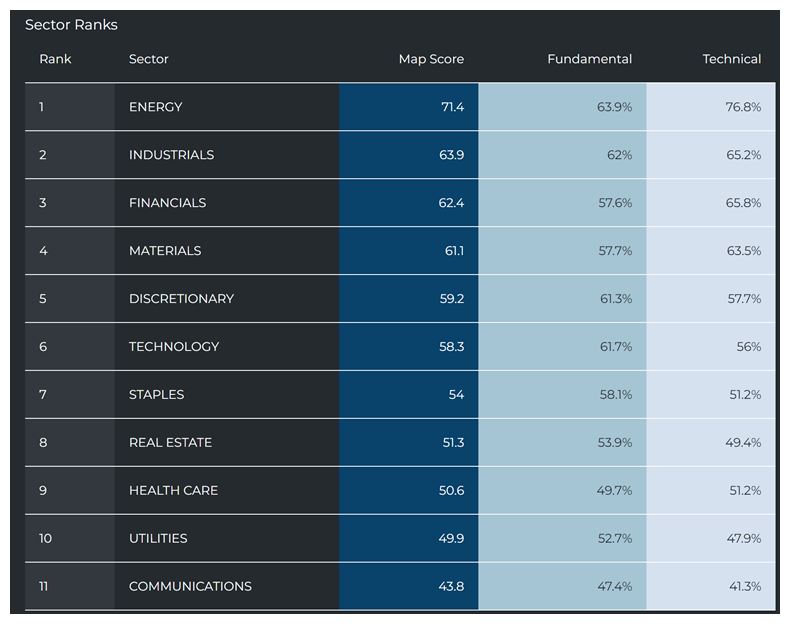
Graphs are for illustrative and discussion purposes only. Please read important disclosures at the end of this commentary.
Energy remains on top while technology continues to slip. Energy buying continues to be strong, but it’s important to note, that tech isn’t falling in the ranks because it’s soft… rather it’s falling because it’s less strong than it was before. We can see that in the chart below: Unusual buying has just slowed down.
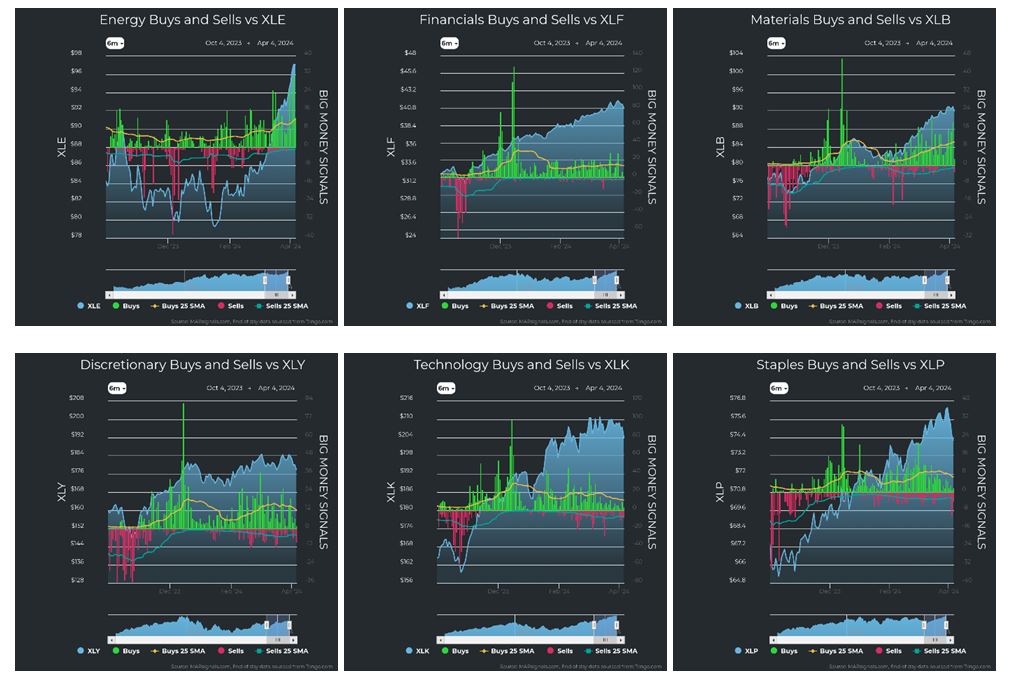
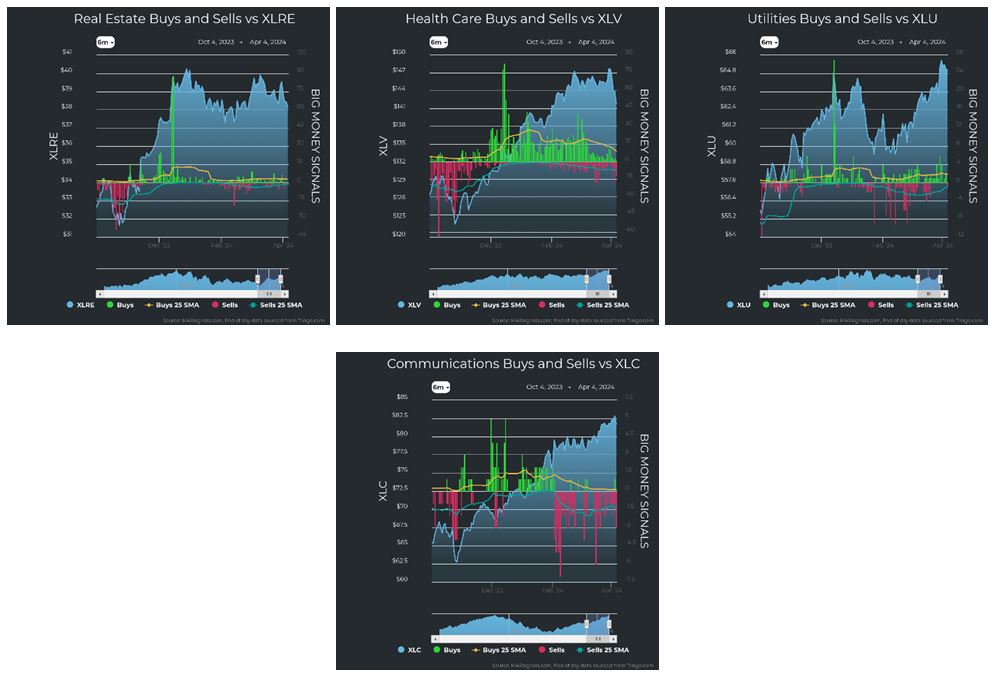
Graphs are for illustrative and discussion purposes only. Please read important disclosures at the end of this commentary.
You’ll also notice that technically, each sector chart continues to look strong. I see no clear price “breaks” to worry about. And when we factor in unusual buying outweighing selling, there’s no reason for concern. If anything, we may be overdue for a pullback, however the BMI is not in overbought territory and continues to glide along around 70%. That’s a healthy clip of buying.
In other words, over the past 25 days, 70% of all signals are unusual buys. That’s good – not bad.
If you need further evidence of how we humans focus our attention, check this out…here are two charts of the NASDAQ. One reflects the news of rate cuts potentially coming in 2024. The other reflects the news of a 4.7 magnitude earthquake hitting New York City. Which do you think is which?
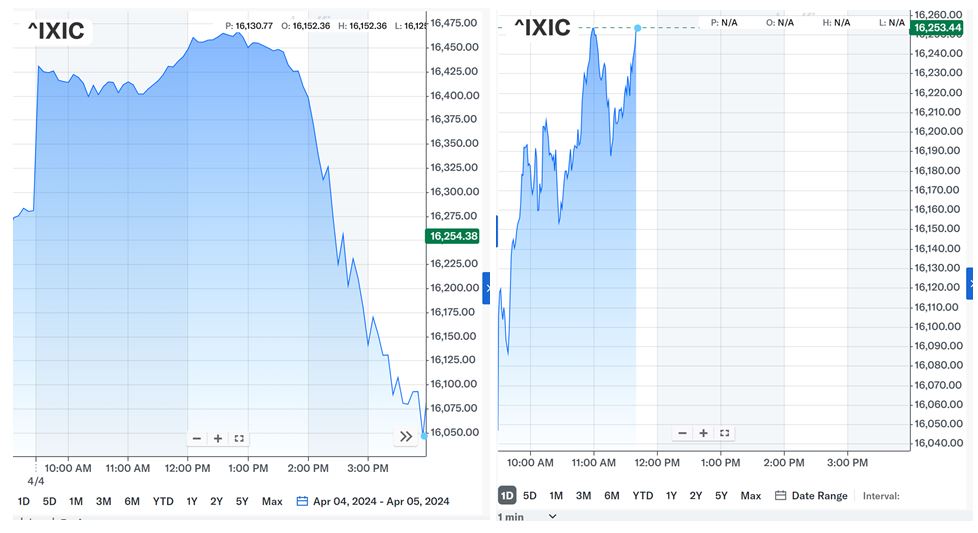
Graphs are for illustrative and discussion purposes only. Please read important disclosures at the end of this commentary.
I’m sure you know by now the rapid decline in the chart on the left was the response to potential rate cut delays. The rise on the right was on a hot jobs report that coincided with an earthquake near New York.
That’s wild. Talk about 0.25% in short-term rates is a market mover, not an earthquake.
Did a technologically sophisticated civilization predate ours? Maybe, I’m not sure… Does the news really run the markets? Or is it the money flows? I think I know the answer there.
“You cannot believe in God until you believe in yourself.” – Swami Vivekananda
All content above represents the opinion of Jason Bodner of Navellier & Associates, Inc.
Also In This Issue
A Look Ahead by Louis Navellier
With Rising Inflation and Bond Rates, is a June Fed Rate Cut Still Likely?
Income Mail by Bryan Perry
Fresh Market Volatility Comes from Unexpected Sources
Growth Mail by Gary Alexander
Why Raising Tax Rates Does NOT Raise More Tax Dollars
Global Mail by Ivan Martchev
With 10-Year Treasuries At 4.4%, How High is Too High?
Sector Spotlight by Jason Bodner
No April Showers on the Horizon
View Full Archive
Read Past Issues Here

Jason Bodner
MARKETMAIL EDITOR FOR SECTOR SPOTLIGHT
Jason Bodner writes Sector Spotlight in the weekly Marketmail publication and has authored several white papers for the company. He is also Co-Founder of Macro Analytics for Professionals which produces proprietary equity accumulation/distribution research for its clients. Previously, Mr. Bodner served as Director of European Equity Derivatives for Cantor Fitzgerald Europe in London, then moved to the role of Head of Equity Derivatives North America for the same company in New York. He also served as S.V.P. Equity Derivatives for Jefferies, LLC. He received a B.S. in business administration in 1996, with honors, from Skidmore College as a member of the Periclean Honors Society. All content of “Sector Spotlight” represents the opinion of Jason Bodner
Important Disclosures:
Jason Bodner is a co-founder and co-owner of Mapsignals. Mr. Bodner is an independent contractor who is occasionally hired by Navellier & Associates to write an article and or provide opinions for possible use in articles that appear in Navellier & Associates weekly Market Mail. Mr. Bodner is not employed or affiliated with Louis Navellier, Navellier & Associates, Inc., or any other Navellier owned entity. The opinions and statements made here are those of Mr. Bodner and not necessarily those of any other persons or entities. This is not an endorsement, or solicitation or testimonial or investment advice regarding the BMI Index or any statements or recommendations or analysis in the article or the BMI Index or Mapsignals or its products or strategies.
Although information in these reports has been obtained from and is based upon sources that Navellier believes to be reliable, Navellier does not guarantee its accuracy and it may be incomplete or condensed. All opinions and estimates constitute Navellier’s judgment as of the date the report was created and are subject to change without notice. These reports are for informational purposes only and are not a solicitation for the purchase or sale of a security. Any decision to purchase securities mentioned in these reports must take into account existing public information on such securities or any registered prospectus.To the extent permitted by law, neither Navellier & Associates, Inc., nor any of its affiliates, agents, or service providers assumes any liability or responsibility nor owes any duty of care for any consequences of any person acting or refraining to act in reliance on the information contained in this communication or for any decision based on it.
Past performance is no indication of future results. Investment in securities involves significant risk and has the potential for partial or complete loss of funds invested. It should not be assumed that any securities recommendations made by Navellier. in the future will be profitable or equal the performance of securities made in this report. Dividend payments are not guaranteed. The amount of a dividend payment, if any, can vary over time and issuers may reduce dividends paid on securities in the event of a recession or adverse event affecting a specific industry or issuer.
None of the stock information, data, and company information presented herein constitutes a recommendation by Navellier or a solicitation to buy or sell any securities. Any specific securities identified and described do not represent all of the securities purchased, sold, or recommended for advisory clients. The holdings identified do not represent all of the securities purchased, sold, or recommended for advisory clients and the reader should not assume that investments in the securities identified and discussed were or will be profitable.
Information presented is general information that does not take into account your individual circumstances, financial situation, or needs, nor does it present a personalized recommendation to you. Individual stocks presented may not be suitable for every investor. Investment in securities involves significant risk and has the potential for partial or complete loss of funds invested. Investment in fixed income securities has the potential for the investment return and principal value of an investment to fluctuate so that an investor’s holdings, when redeemed, may be worth less than their original cost.
One cannot invest directly in an index. Index is unmanaged and index performance does not reflect deduction of fees, expenses, or taxes. Presentation of Index data does not reflect a belief by Navellier that any stock index constitutes an investment alternative to any Navellier equity strategy or is necessarily comparable to such strategies. Among the most important differences between the Indices and Navellier strategies are that the Navellier equity strategies may (1) incur material management fees, (2) concentrate its investments in relatively few stocks, industries, or sectors, (3) have significantly greater trading activity and related costs, and (4) be significantly more or less volatile than the Indices.
ETF Risk: We may invest in exchange traded funds (“ETFs”) and some of our investment strategies are generally fully invested in ETFs. Like traditional mutual funds, ETFs charge asset-based fees, but they generally do not charge initial sales charges or redemption fees and investors typically pay only customary brokerage fees to buy and sell ETF shares. The fees and costs charged by ETFs held in client accounts will not be deducted from the compensation the client pays Navellier. ETF prices can fluctuate up or down, and a client account could lose money investing in an ETF if the prices of the securities owned by the ETF go down. ETFs are subject to additional risks:
- ETF shares may trade above or below their net asset value;
- An active trading market for an ETF’s shares may not develop or be maintained;
- The value of an ETF may be more volatile than the underlying portfolio of securities the ETF is designed to track;
- The cost of owning shares of the ETF may exceed those a client would incur by directly investing in the underlying securities; and
- Trading of an ETF’s shares may be halted if the listing exchange’s officials deem it appropriate, the shares are delisted from the exchange, or the activation of market-wide “circuit breakers” (which are tied to large decreases in stock prices) halts stock trading generally.
Grader Disclosures: Investment in equity strategies involves substantial risk and has the potential for partial or complete loss of funds invested. The sample portfolio and any accompanying charts are for informational purposes only and are not to be construed as a solicitation to buy or sell any financial instrument and should not be relied upon as the sole factor in an investment making decision. As a matter of normal and important disclosures to you, as a potential investor, please consider the following: The performance presented is not based on any actual securities trading, portfolio, or accounts, and the reported performance of the A, B, C, D, and F portfolios (collectively the “model portfolios”) should be considered mere “paper” or pro forma performance results based on Navellier’s research.
Investors evaluating any of Navellier & Associates, Inc.’s, (or its affiliates’) Investment Products must not use any information presented here, including the performance figures of the model portfolios, in their evaluation of any Navellier Investment Products. Navellier Investment Products include the firm’s mutual funds and managed accounts. The model portfolios, charts, and other information presented do not represent actual funded trades and are not actual funded portfolios. There are material differences between Navellier Investment Products’ portfolios and the model portfolios, research, and performance figures presented here. The model portfolios and the research results (1) may contain stocks or ETFs that are illiquid and difficult to trade; (2) may contain stock or ETF holdings materially different from actual funded Navellier Investment Product portfolios; (3) include the reinvestment of all dividends and other earnings, estimated trading costs, commissions, or management fees; and, (4) may not reflect prices obtained in an actual funded Navellier Investment Product portfolio. For these and other reasons, the reported performances of model portfolios do not reflect the performance results of Navellier’s actually funded and traded Investment Products. In most cases, Navellier’s Investment Products have materially lower performance results than the performances of the model portfolios presented.
This report contains statements that are, or may be considered to be, forward-looking statements. All statements that are not historical facts, including statements about our beliefs or expectations, are “forward-looking statements” within the meaning of The U.S. Private Securities Litigation Reform Act of 1995. These statements may be identified by such forward-looking terminology as “expect,” “estimate,” “plan,” “intend,” “believe,” “anticipate,” “may,” “will,” “should,” “could,” “continue,” “project,” or similar statements or variations of such terms. Our forward-looking statements are based on a series of expectations, assumptions, and projections, are not guarantees of future results or performance, and involve substantial risks and uncertainty as described in Form ADV Part 2A of our filing with the Securities and Exchange Commission (SEC), which is available at www.adviserinfo.sec.gov or by requesting a copy by emailing info@navellier.com. All of our forward-looking statements are as of the date of this report only. We can give no assurance that such expectations or forward-looking statements will prove to be correct. Actual results may differ materially. You are urged to carefully consider all such factors.
FEDERAL TAX ADVICE DISCLAIMER: As required by U.S. Treasury Regulations, you are informed that, to the extent this presentation includes any federal tax advice, the presentation is not written by Navellier to be used, and cannot be used, for the purpose of avoiding federal tax penalties. Navellier does not advise on any income tax requirements or issues. Use of any information presented by Navellier is for general information only and does not represent tax advice either express or implied. You are encouraged to seek professional tax advice for income tax questions and assistance.
IMPORTANT NEWSLETTER DISCLOSURE:The hypothetical performance results for investment newsletters that are authored or edited by Louis Navellier, including Louis Navellier’s Growth Investor, Louis Navellier’s Breakthrough Stocks, Louis Navellier’s Accelerated Profits, and Louis Navellier’s Platinum Club, are not based on any actual securities trading, portfolio, or accounts, and the newsletters’ reported hypothetical performances should be considered mere “paper” or proforma hypothetical performance results and are not actual performance of real world trades. Navellier & Associates, Inc. does not have any relation to or affiliation with the owner of these newsletters. There are material differences between Navellier Investment Products’ portfolios and the InvestorPlace Media, LLC newsletter portfolios authored by Louis Navellier. The InvestorPlace Media, LLC newsletters contain hypothetical performance that do not include transaction costs, advisory fees, or other fees a client might incur if actual investments and trades were being made by an investor. As a result, newsletter performance should not be used to evaluate Navellier Investment services which are separate and different from the newsletters. The owner of the newsletters is InvestorPlace Media, LLC and any questions concerning the newsletters, including any newsletter advertising or hypothetical Newsletter performance claims, (which are calculated solely by Investor Place Media and not Navellier) should be referred to InvestorPlace Media, LLC at (800) 718-8289.
Please note that Navellier & Associates and the Navellier Private Client Group are managed completely independent of the newsletters owned and published by InvestorPlace Media, LLC and written and edited by Louis Navellier, and investment performance of the newsletters should in no way be considered indicative of potential future investment performance for any Navellier & Associates separately managed account portfolio. Potential investors should consult with their financial advisor before investing in any Navellier Investment Product.
Navellier claims compliance with Global Investment Performance Standards (GIPS). To receive a complete list and descriptions of Navellier’s composites and/or a presentation that adheres to the GIPS standards, please contact Navellier or click here. It should not be assumed that any securities recommendations made by Navellier & Associates, Inc. in the future will be profitable or equal the performance of securities made in this report.
FactSet Disclosure: Navellier does not independently calculate the statistical information included in the attached report. The calculation and the information are provided by FactSet, a company not related to Navellier. Although information contained in the report has been obtained from FactSet and is based on sources Navellier believes to be reliable, Navellier does not guarantee its accuracy, and it may be incomplete or condensed. The report and the related FactSet sourced information are provided on an “as is” basis. The user assumes the entire risk of any use made of this information. Investors should consider the report as only a single factor in making their investment decision. The report is for informational purposes only and is not intended as an offer or solicitation for the purchase or sale of a security. FactSet sourced information is the exclusive property of FactSet. Without prior written permission of FactSet, this information may not be reproduced, disseminated or used to create any financial products. All indices are unmanaged and performance of the indices include reinvestment of dividends and interest income, unless otherwise noted, are not illustrative of any particular investment and an investment cannot be made in any index. Past performance is no guarantee of future results.
